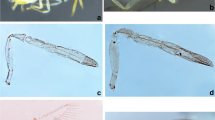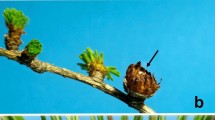Abstract
The world’s sole ‘parasitic’ gymnosperm Parasitaxus usta (Podocarpaceae) is endemic to the island of Grande Terre, New Caledonia. It is a threatened species because of its limited geographic range and progressing habitat fragmentation. Here, we report a novel scale insect outbreak on a Parasitaxus sub-population from Monts Dzumac in the southern part of Grande Terre. The identity of the scale insect was determined through combining morphological and molecular methods. The field collection of scale insects and their secretions from infested Parasitaxus specimens allowed morphological identification of the superfamily Coccoidea. Subsequent genetic sequencing using CO1 markers allowed phylogenetic placement of the wax scale insects to the genus Ceroplastes (Coccoidea, Coccidae), a widespread pest genus. The identified species, C. pseudoceriferus, has not been previously recorded from New Caledonia. As Parasitaxus is already vulnerable to extinction, this new threat to its long-term survival needs to be monitored. Other New Caledonian endemic plant species are potentially at risk of this new species, although it was not observed on Falcatifolium taxoides, the host of Parasitaxus.



Similar content being viewed by others
References
Ben-Dov Y (1997) Diagnosis. In: Ben-Dov Y, Hodgson CJ (eds) Soft scale insects: their biology, natural enemies and control. Elsevier Science Publishers, Amsterdam, pp 3–4
Brun LO, Chazeau J (1986) Catalogue des ravageurs d’intérêt agricole de Nouvelle-Calédonie. 2e edition. ORSTOM, Nouméa
Castresana J (2000) Selection of conserved blocks from multiple alignments for their use in phylogenetic analysis. Mol Biol Evol 17:540–552
Cherrier J-F, Gondran M, Woltz P, Vogt G (1992) Parasitisme interspécifique chez les gymnospermes; données inédites chez deux Podocarpaceae endémiques Néo-Calédoniennes. Revue de cytologie et de biologie végétales – Le Botaniste 15:65–87
Darriba D, Taboada GL, Doallo R, Posada D (2012) Jmodeltest 2: more models, new heuristics and parallel computing. Nat Methods 9:772
de Laubenfels DJ (1959) Parasitic conifer found in New Caledonia. Science 130:97
Deng J, Yu f, Zhang TX, Hu HY, Zhu CD, Wu SA, Zhang YZ (2012) DNA barcoding of six Ceroplastes species (Hemiptera: Coccoidea: Coccidae) from China. Mol Ecol Resour 12:791–796
Feild TS, Brodribb TJ (2005) A unique mode of parasitism in the conifer coral tree Parasitaxus ustus (Podocarpaceae). Plant Cell Environ 28:1316–1325
Gouy M, Guindon S, Gascuel O (2010) Seaview version 4: a multiplatform graphical user interface for sequence anignment and phylogenetic tree building. Mol Biol Evol 27:221–224
Gullan PJ, Kosztarab M (1997) Adaptations in scale insects. Ann Rev Entomol 42:23–50
Jaffré T (1995) Distribution and ecology of the conifers of New Caledonia. In: Enright NJ, Hill RS (eds) Ecology of the southern conifers. Smithsonian Press, Washington, DC, pp 171–196
Kimura M (1980) A simple method for estimating evolutionary rates of base substitutions through comparative studies of nucleotide sequences. J Mol Evol 16:111–120
Köpke E, Musselman IJ, de Laubenfels DJ (1981) Studies on the anatomy of Parasitaxus ustus and its root connections. Phytomorphology 31:85–92
Lin CP, Wood TK (2002) Molecular phylogeny of the North American Enchenopa binotata (Homoptera: Membracidae) species complex. Ann Entomol Soc Am 95:162–171
Mahfoudhi N, Digiaro M, Dhouibi MH (2009) Transmission of grapevine leafroll viruses by Planococcus ficus (Hemiptera: Pseudococcidae) and Ceroplastes rusci (Hemiptera: Coccidae). Plant Dis 93:999–1002
Ronquist F, Huelsenbeck JP (2003) Bayesian phylogenetic inference under mixed models. Bioinformatics 19:1572–1574
Schwarz G (1978) Estimating the dimension of a model. Ann Stat 6:461–464
Simon C, Frati F, Beckenbach A, Crespi B, Liu H, Flook P (1994) Evolution, weighting, and phylogenetic utility of mitochondrial gene sequences and a compilation of conserved polymerase chain reaction primers. Ann Entomol Soc Am 87:651–701
Sinclair WT, Mill RR, Gardner MF, Woltz P, Jaffre T, Preston J, Hollingsworth ML, Ponge A, Moller M (2002) Evolutionary relationships of the New Caledonian heterotrophic conifer, Parasitaxus usta (Podocarpaceae), inferred from chloroplast trnL-F intron/spacer and nuclear rDNA ITS2 sequences. Plant Syst Evol 233:79–104
Tamaki Y (1997) Chemistry of the test cover. In: Ben-Dov Y, Hodgson CJ (eds) Soft scale insects: their biology, natural enemies and control, vol 7 A. Elsevier, Amsterdam, pp 55–72
Tamaki Y, Yushima T, Kawai S (1969) Wax secretion in a scale insect, Ceroplastes pseudoceriferus Green (Homoptera : Coccidae). Appl Entomol Zool 4:126–134
Thomas P (2010) Parasitaxus usta. In: The IUCN Red List of Threatened Species 2010: e.T31002A9597883. 10.2305/IUCN.UK.2010-3.RLTS.T31002A9597883.en. Downloaded on 09 June 2016.
Woltz P, Stockey RA, Gondran M, Cherrier JF (1994) Interspecific parasitism in the gymnosperms: unpublished data on two endemic New Caledonian Podocarpaceae using scanning electron microscopy. Acta Bot Gallica 141:731–746
Acknowledgements
We thank Jérôme Munzinger (Montpellier) and Kerstin Schmidt (Jena) for help in the preparation of our fieldwork in New Caledonia. Fieldwork and collection in southern New Caledonia were kindly permitted by the Direction de l’Environnement (Province Sud), permit nº 17778/DENV/SCB delivered in November 2011. Support for L.J.S. was provided by the Dorothea Schlözer program, Göttingen. Partial support for fieldwork was provided to V. P. by Grant OSUR (Univ. Rennes 1) from program AO1.P4.
Author information
Authors and Affiliations
Corresponding author
Additional information
Handling Editor: Heikki Hokkanen.
Electronic supplementary material
Below is the link to the electronic supplementary material.
Rights and permissions
About this article
Cite this article
Seyfullah, L.J., Beimforde, C., Perrichot, V. et al. Parasitaxus parasitized: novel infestation of Parasitaxus usta (Podocarpaceae). Arthropod-Plant Interactions 11, 507–514 (2017). https://doi.org/10.1007/s11829-016-9494-0
Received:
Accepted:
Published:
Issue Date:
DOI: https://doi.org/10.1007/s11829-016-9494-0




